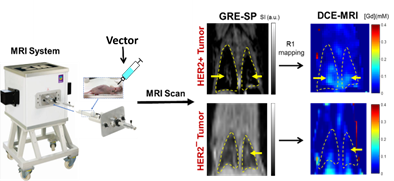
Diagnosis of HER2+ cancer metastasis lesions in mouse using a genetically engineered targeted vector in conjunction with MRI. The MRI followed by voxel-by-voxel analysis of scans showed that the vector makes it possible to differentiate HER2+ from HER2- cancer lesions in mouse lungs
Invention Summary:
The human epidermal growth factor receptor-2 (HER2) is overexpressed in different cancers and has been used as an important biomarker for aggressive tumors with metastatic potential. Currently in clinic, cancer diagnosis includes whole body imaging using computed tomography (CT) and/or positron emission tomography (PET). However, these imaging methods do not provide information regarding the presence or absence of cancer-specific cell surface biomarkers such as HER2. Therefore, a sensitive non-invasive HER2-specific imaging method is needed to provide such information.
Rutgers scientists have invented a novel modular vector platform that can be used for cancer diagnosis, treatment, and evaluation of response to different therapy for cancer treatment. The recombinant vector is a targeted system comprised of a single-domain antibody against HER2 for targeting fused to a highly soluble peptide to extend its half-life. The vector is labeled with gadolinium (Gd) to make it suitable for magnetic resonance imaging (MRI). In in vivo models, this system allows the visualization of HER2+ lesions of ovarian cancer lung metastasis by MRI. This vector also shows a high affinity toward HER2, long blood circulation time, and high signal-to-noise ratio of detection. Due to its ability to detect HER2+ cancer lesions, it can be used to facilitate tumor visualization, HER2 diagnosis, and targeted therapy.
Market Applications:
- Non-invasive diagnosis of HER2+ tumors
- Simultaneous imaging and therapy of cancer
- Evaluation of response to immunotherapy
Advantages:
- High Specificity and affinity toward HER2
- Non-invasive
- Modular blood circulation time
- High signal-to-noise ratio
- Expected low toxicity and immunogenicity
- Rapid and safe platform for tumor characterization
Intellectual Property & Development Status:
Patent pending. Available for licensing and/or research collaboration.